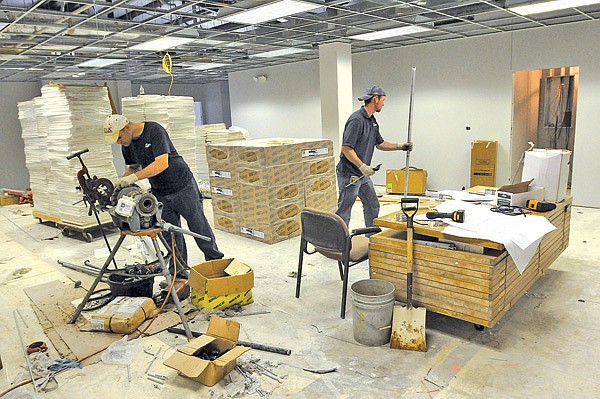Gateway Gets New Site
Programs To Share Building On Southeast 14th Street
Michael Cormier, left, and Josh Ferguson, both with Freedom Fire Pro in Rogers, work in the common area of the Bentonville Public Schools building at 1002 S.E. 14th St. in Bentonville, installing a fire suppression system. The School District is renovating the building it bought recently to house its high school alternative learning program.
Monday, July 15, 2013
BENTONVILLE — Bentonville’s alternative education program will open the new school year in a new place.
The Gateway program, which will celebrate its five-year anniversary this fall, is moving about half-mile from Bentonville High School to 1002 S.E. 14th St., a building the School District bought in December. Gateway will share the building with the district’s English as a Second Language program.
At A Glance
Building Costs
The Bentonville School Board agreed in December to buy the building at 1000 and 1002 S.E. 14th St. for $2.5 million. That money came from the district’s reserve. The district is spending another $427,000 to renovate the space to fit the Gateway program’s needs. Half of the building is leased to Novar, an energy management company, for $13,000 per month.
District officials originally discussed including money to lease or purchase a building for a Gateway expansion in the June 2012 millage election. Administrators nixed that plan, however, in order to lower the cost of the millage.
Source: Staff Report
Michael Poore, school district superintendent, said getting Gateway its own facility has been his goal since before he started the job in July 2011.
“Even before I officially became superintendent, I was driving around looking at sites for Gateway,” Poore said. “Board members have had a lot of passion about trying to find a way to expand. The thing I’m most excited about is this program doesn’t deserve to be in a trailer in the back lot. There are great kids in this program and they deserve a quality facility.”
Gateway offers small-class settings and alternative methods for students who have trouble learning in a traditional way. Classes are limited to 15 students. Semesters are nine weeks long, but students balance only four classes at a time instead of the seven or eight classes taken by students in the traditional high school setting.
Renovation of the building to accommodate Gateway began the second week of June, said Paul Wallace, facilities director. Sellers Properties Inc., based in Springdale, is handling the project. It is expected to be completed by Aug. 19, the first day of school, Wallace said.
“The contractor is doing a good job,” Wallace said. “It’s going along as planned. It was just a tighter schedule than we’d normally like for this kind of project.”
Floor plans for the facility include six classrooms, a commons area, a computer lab and several offices. There also will be a bicycle repair shop, something Gateway adopted last year after the district received more than 500 bicycles that were distributed to each school. Gateway students will repair those bikes. Plans are to eventually extend the repair shop’s services to the rest of the community.
Gateway began with a capacity of 45 students during its first year in 2008. It expanded to 60 students in its second year. It has stayed at that level since then, said Jason Jedamski, who was an assistant principal at Bentonville High School for four years. Jedamski’s last day at the school was Friday; he left for a new job in Broken Arrow, Okla.
Jedamski said, on average, a Gateway student raises his grade point average by one point while in the program.
He points to additional evidence of Gateway’s benefits. The year before Gateway started, only seven out of 100 students the school had deemed most at risk went on to graduate. About 60 percent of Gateway students graduate, Jedamski said.
The goal is to get students back onto a regular schedule at the high school, he said.
“Gateway has been a very successful program, but just the image of an alternative program being in trailers is a negative for people who don’t understand the purpose,” Jedamski said. “By having its own facility, the program will be viewed differently on the surface, and it gives the program a chance to develop an identity separate from the high school. It has come a long way, and they’ll continue to build that culture of student success.”
Not everyone agrees with moving Gateway away from the high school.
Blake Dover, a 2012 Bentonville High School graduate who went through Gateway, said he liked being around his friends at the school.
“I don’t think they should move it,” Dover said. “I liked it where it was.”
But Dover is complimentary of the program. He said he would recommend it for certain students.
“It was a good community. The teachers are friendly,” he said.
Poore said he hopes to expand Gateway’s capacity from 60 to 90 students, but the district’s financial situation has put that goal on hold.
“Our challenge is that we’re opening up traditional schools as well, and that takes a toll on our budget,” he said. “We’re trying to maintain a healthy fund balance.”
The district receives about 50 percent more money from the state for alternative-education students as it does for students in the traditional setting.
The new facility will have six teachers, a counselor and a registrar who will perform many different tasks, Jedamski said. There won’t be an administrator, but James Boyster will be designated as the site’s lead teacher.
